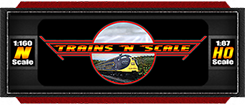 Loading... Please wait...
Loading... Please wait...-
Call us at: 941-500-2288
-
Mail Us at: Trains N Scale P.O. Box 178 Lehigh Acres, FL 33970-0178
- My Account
- Items / $0.00
All prices are in All prices are in USD
Categories
- Home
- Models and Prototypes Blog
- What is HO Scale?
What is HO Scale?
Posted by Neville C. Wilson on 15th Jun 2017
With rails spaced 16.5 mm apart (as measured between the inner sides of the rail) and a proportion (i.e., its size in relation to that of the prototype) of 1:87, HO (pronounced " aitch-oh") Scale is considered to be the world's most popular choice for railway models.
Almost half the size of previously common 1:48 O Scale models (which made their debut in the early 1900s), because of their operational characteristics, price, size, and ability to accommodate a wealth of details, sales of HO (i.e., "Half O") Scale products eventually overtook those of O in the 1960s.
Though the manufacture of 1:76 00 Scale trains (which also typically run on 16.5 mm spaced rails) predated that of HO by more than a decade, initially marketed as an alternative scale, the latter size gained widespread acceptance in North America and continental
As the overall interest in toy train models eventually waned, manufacturers still engaged in HO Scale train production began emphasizing realism and model railroading as a hobby.
While traditionally gauged OO remains dominant in the
Although some OO scale products may be marketed as being useable for both OO and HO, they tend to be larger than the established proportions for North American and continental European HO models.
S Scale modelers often utilize readily available 16.5 mm wide track to represent Sn3½ scale three foot six inch narrow gauge lines.
in HO, commercially produced Z Scale (6.5 mm/0.256 inch) track products may be used when modeling 15 inch narrow gauge HOz (NMRA) and HOi (NEM) lines, while similarly manufactured N Scale (9 mm/0.354 inch) track is frequently used to model two foot six inch narrow gauge HOn30 (NMRA) or HOn2½ and HOe (NEM) railway systems.

How standard gauge Z, N, HO, and O Scale Model Train Locomotives Compare In Size
As is the case with prototype railways, HO scale manufacturers produce rail in different heights.
Expressed in thousandths of an inch, track "Code" refers to the measured height of the manufactured model rail.
Extremely popular and approximately 8.75 percent larger than the heaviest prototype Code 155 main line rail used by the Pennsylvania Railroad, Code 100 (i.e., 0.100-inches tall or about 8.7 scale inches high) track has been the industry standard for many years.
Typically designed for modelers seeking products that are closer to scale, manufacturers also produce track in Code 83 (0.083 inches tall, which represents 7.23 scale inch high main line 134 pound per yard rail) and Code 70 (0.070 inches tall, which represents 6.1 scale inch high main line 100 pound per yard rail).
There are several caveats to consider when adopting more scale-like rail:
1. Older HO Scale models may need to have their wheels and/or wheel-sets modified or replaced because of the height of the factory supplied wheel flanges, which will often hit the top of the simulated spike heads that secure the low profile rails to their ties or sleepers. Retrofitting rolling-stock with aftermarket low-profile wheel-sets is fairly easy, and can usually be done at moderate cost
2. Though the tolerances of wheels and wheel-sets should be checked before newly acquired models are initially run, closer attention must be paid to wheel gauge and flange heights whenever low-profile rail is utilized.
View additional articles like this one in the Trains N Scale™ Models and Prototypes Blog.
Recent Posts
- » A Quick Look: InterMountain Fox Valley Red Caboose Autoracks Review
- » A Quick Look: Athearn 2293 N UPS Wedge Trailers and Dolly
- » A Quick Look: Atlas N 1993 Ford Explorer SUV 5th Run Review
- » A Quick Look: Eastern Seaboard Models N Metal Wheel-Sets Review
- » A Quick Look: Jacksonville Terminal JTC NSC 53' Well Cars Review
